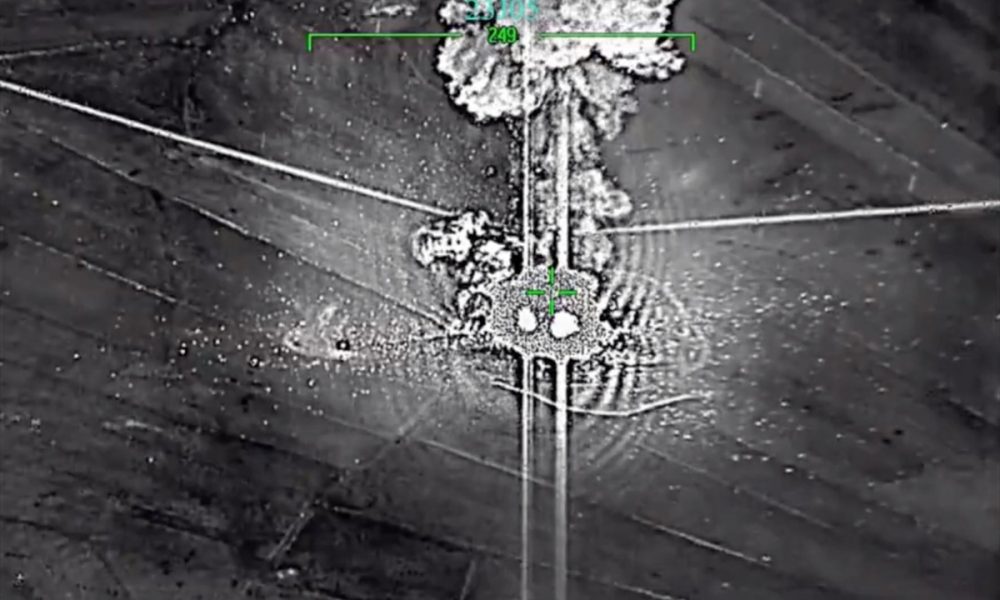A Turkish drone was shot down yesterday as Turkey intensified its airstrikes against PYD targets in Syria. A Turkish Defense Ministry official, speaking to Reuters news agency, revealed that the downed Unmanned Combat Aerial Vehicle (UCAV) did not belong to the Turkish Armed Forces. Following this unofficial statement, it was clarified that the drone belonged to Turkey’s National Intelligence Organization (MIT). A US official later confirmed that US F-16s had shot down the Turkish UCAV in Syrian airspace. Subsequently, an official statement was issued by the Pentagon.
“Preliminary assessments by US commanders identified an unmanned aerial vehicle (UAV) less than half a kilometer from US forces as a potential threat. In self-defense, US F-16 fighter jets engaged and downed the UAV,” stated Pentagon spokesman Brigadier General Patrick Ryder, who described the incident as “regrettable.” Ryder clarified that one of the Turkish UCAVs involved in airstrikes in Hasakah had entered a US “restricted area of operations” and had approached US soldiers stationed in bunkers to within less than a kilometer. The UCAV was assessed as a “potential threat” and subsequently shot down at 11:40 a.m. local time.
Ryder emphasized that there was no evidence suggesting that Turkey had deliberately targeted US forces.
Key points from the US statements:
- The downing of the UCAV was not accidental.
- The decision to engage the UCAV was made through the chain of command.
- The decision was taken despite the absence of any indication that Turkey had targeted US forces.
The Turkish Foreign Ministry issued a statement later in the day, explaining the incident: “During the operation, a UCAV was lost due to differing technical assessments within the de-escalation mechanism involving third parties. Measures are being implemented to enhance the effectiveness of the de-escalation mechanism with relevant parties. The incident in question has had no impact on the ongoing operation and the successful targeting of identified objectives.”
Key points from the Turkish side’s statement:
- The US is referred to as a third party.
- The incident is attributed to technical discrepancies.
- Measures are being taken to prevent a recurrence of such incidents.
- The drone incident has not affected Turkey’s ongoing operations.
Retired Lieutenant General İsmail Hakkı Pekin, former Chief of Intelligence of the General Staff, suggests that the US intentionally shot down Turkey’s UCAV: “This marks the first time a NATO member has engaged another NATO member’s UCAV. With this action, the US is responding to Turkey’s operations against the PYD. This incident is significant in demonstrating what actions the US is willing to take in response to actions it opposes.”
Asked about the potential impact of the UCAV incident on Turkey-US relations, Pekin responded, “The consequences of this incident will become apparent in the near future, including its implications and repercussions. A clearer picture will emerge based on the developments in ongoing operations, Turkey’s parliamentary approval of Sweden’s NATO accession, and the sale of F-16s to Turkey.”
Pekin highlighted that Turkey continued its operations following the UCAV’s downing and the reported casualties in the attack on a Turkish base. “The operation began with MIT’s UAVs and UCAVs. After the UCAV was shot down and casualties occurred, the Air Force was activated. F-16s played a critical role due to their effectiveness and carrying capacity compared to UCAVs.”
More Details
The intensified airstrikes following Foreign Minister Hakan Fidan’s statement, “All infrastructure, superstructure, and energy facilities belonging to the PKK/YPG in Iraq and Syria are the legitimate targets of our security forces, armed forces, and intelligence elements from now on,” differ from Turkey’s previous operations in Syria in several ways:
- The focus is on targeting the terrorist organization’s sources of income, such as oil facilities and power plants, rather than individual terrorists.
- The operations do not appear to aim at gaining control or securing specific regions through ground operations.
- The priority is to disrupt the PYD’s connectivity in northern Syria and with Iraq.
- Diplomatic efforts appear to be in progress before and during the operation, as indicated by the prominent role of the Minister of Foreign Affairs alongside the Minister of National Defense.
The overarching goal of the operation remains consistent: preventing the PYD from establishing an autonomous or independent entity on Turkey’s border.
Built-up Area Caution
Pekin warned of the possibility of terrorist activities spreading to residential areas following these operations: “The attack in Ankara was already a sign of this shift. With Turkish drones and UCAVs restricting movement in rural areas, the terrorist organization may have adopted a new strategy. Turkey must take precautions accordingly.”

